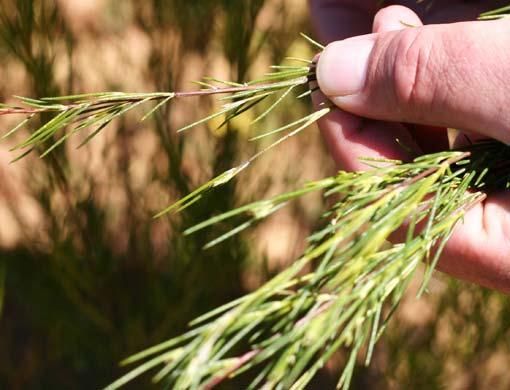Clanwilliam is a sleepy town of less than 5,000 people in rugged, rural South Africa. Not long ago, bushmen foraged a living in the arid scrubland around town; today, farmers drive over dusty roads in 4x4s to check on their crops.
It is not exactly trendy.
But in upscale cafés in the US and Europe, consumers are clamouring for something only Clanwilliam has. They want rooibos — a naturally sweet and caffeine-free tea that has become the new "in" drink for the health-conscious, a plant only grown within a 60-mile radius of this town.
Centuries ago, rooibos was a drink of the bushmen, who chopped the bush's stalks, bruised them, and let them dry in the sun — to be sipped later in a warm brew over fires. Today, customers pay $3 for a cup of rooibos or $16 to $24 for a pound in bulk retail. (The wholesale price is less than $3 a pound.) The popular Tea Spot in New York's West Village sells a variety of rooibos blends, including one with cinnamon, ginger, vanilla and lemon grass. Last year, Celestial Seasonings sold about 350,000 boxes of its rooibos-based teas, including "Red Safari Spice" and "African Orange Mango". Even Starbucks sells rooibos.
"It was eight or nine years ago that we added rooibos to our menu," says Michelle Brown, the co-owner of Teaism, a Washington DC shop that sells a "Star of Africa" blend that includes rooibos, yellow plum, orange, apple, papaya and pineapple. "Since then, the popularity has increased tremendously. It's just got good flavour: it's good iced, it's good hot, it's good with milk and sugar — it's good so many ways."
For Clanwilliam, this means business. In 2004, growing demand pushed up rooibos prices from 70 cents a pound to over $2, encouraging more farmers to grow the bush. Now there are more than 450 rooibos farmers — up from about 220 three years ago. This year's was the biggest harvest: 15,000 tonnes, now heading to distributors in Germany, Japan, England and the US.
"Rooibos has been very good to the farmers lately," says Arend Redelinghuys, group marketing manager at Rooibos Ltd, the world's biggest supplier of rooibos tea and one of the region's largest employers.
Although prices dropped this year due to increased supply, people in the business say farmers are still keen to go on planting. And they are confident the demand for the bushman's plant will keep growing.
Back to the roots
The story of the little plant that made it big starts in the Cedarberg Mountains.
At first glance, the rooibos bush is unremarkable. It is spindly, with needle-like stalks — just another scrub in the fynbos, the rich heathland of western South Africa.
Despite its name, it is not red but earthy green. Rooibos or "red bush" in Afrikaans refers to the plant after fermentation, when its stalks turn a deep auburn.
According to local lore, it was a Russian immigrant named Benjamin Ginsberg who first recognised the plant's economic potential. In 1904, he started trading with local bushmen and sold it as "mountain tea" across South Africa. Three decades later, a doctor named P. Le Fras Nortier convinced local white farmers to cultivate it.
The market grew, slowly and steadily, for the next few decades.
Then, with a health-and-natural-food craze in the West, Rooibos Ltd saw a perfect opportunity. It hired public relations consultants to help spread the word: Rooibos is good for you. The tea, they pointed out, is caffeine-free (most decaffeinated drinks go through a chemical process) and nutty sweet (no sugar needed). They publicised studies on rooibos's health benefits. And sales started creeping upwards.
Sarah Haynes, who runs rooibos marketing campaigns in Britain, says rooibos started as a health food in Britain but soon spread to mainstream stores and cafés. Between 1998 and 2003, Rooibos Ltd's exports increased 400 per cent. Today, the company sells to 40 countries.
The US is the fourth largest importer of rooibos, after Germany, Britain and the Netherlands. Still, rooibos makes up only a quarter of one per cent of world tea output.
Producers hope that Western consumers — now familiar with the tea — will follow South Africa's lead and start using the plant in other ways. Here, rooibos is used in cosmetics — from lotion to soap and shampoo — and is said to improve skin tone and help hair growth. It is also an all-purpose seasoning, used in everything from creme brûlées to lamb chops to jellies, giving food a sweet, nutty taste.
"The next step will be to open people's eyes to the fact that it's an ingredient," says Haynes. "It's got a phenomenal flavour that you just don't get anywhere else.
Tasty routine
Johan Brand knows all about the rooibos flavour. At Rooibos Ltd, he, like many other employees, tastes about 18 cups of it a day between January and June.
Brand acts as a liaison between the company and farmers. Brand advises all of the area's 450 farmers about how to solve the problems of the crop: bugs, moles and fungus. He also helps farmers appease the Western consumer base with tips on growing pesticide-free and organic rooibos.
Some in the industry are pushing for a label to designate true rooibos — something equivalent to France's champagne label, where winemakers from the Champagne region are prohibited from calling their product "champagne" unless it meets certain standards.
"You know, it has to come from a certain region but it also has to have a certain quality," he says, standing in a wind-swept field of scraggly green bushes.
Bushmen's brew to haute tea
South Africa's unique red beverage, Rooibos, is taking the world by storm



